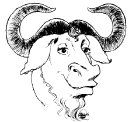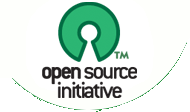Unix, 自由软件组织(FSF)和开源软件运动(OSI)历史
作者 陈怀临 | 2008-02-20 16:13 | 类型 专题分析 | Comments Off
|
Unix, 自由软件组织(FSF)和开源软件运动(OSI)历史
前言: 本文是笔者在2005年7月撰写的关于Unix, 自由软件组织(FSF)和开源软件运动(OSI)的历史。考据和撰写这篇文章的目的是把Unix, FSF和OSI这互相既紧密联系相关,又有细微区别的计算机发展中的三个大方向首次系统的综合在一起以饷读者。让读者在商业社会的今天,也能感知和欣赏这这个世界上存在着那样的一批人,对自由和理想的追求。 Unix, FSF和OSI历史考: 1965: the Massachusetts Institute of Technology, AT&T Bell Labs, and General Electric worked on an experimental operating system called Multics (Multiplexed Information and Computing Service), which was designed to run on the GE-645 mainframe computer.
April 1969: AT&T made a decision to withdraw Multics and go with GECOS. When Multics was withdrawn Ken Thompson and Dennis Ritchie needed to rewrite an operating system in order to play space travel on another smaller machine (a DEC PDP-7 [Programmed Data Processor 4K memory for user programs). The result was a system which a punning colleague called UNICS (UNiplexed Information and Computing Service)–an ‘emasculated Multics’.
September, 1969: Unix was developed.
November 3, 1971: First Edition of UNIX Released.
December 6, 1972: Second Edition of UNIX Released.
December 28, 1969: Linus Torvalds Was Born.
1972: Dennis Ritchie created the C language.
February, 1973: Third Edition of UNIX Released.
November 1973: Fourth Edition of UNIX Released.
November 1973: Ken Thompson and Dennis Ritchie presented the first UNIX paper at the Symposium on Operating Systems Principles at Purdue University
June, 1974: Fifth Edition of UNIX Released.
May, 1975: Sixth Edition of UNIX Released.
Late 1977: 1BSD Released Mid, 1978: 2BSD Released
January, 1979: Seventh Edition of UNIX Released.
Late 1979: 3BSD Released.
1979: SCO Inc. Founded by Doug and Larry Michels as UNIX porting and consulting company.
October, 1980: 4BSD Released.
June, 1981: 4.1BSD Released.
September 27, 1983: Richard Stallman (RSM) announced GNU (GNU’s Not Unix) project publicly on the net.unix-wizards and net.usoft newsgroups. The original post could be found at here.
September, 1983: 4.2BSD Released.
January 5, 1984, RSM quitted his job from MIT and start work on GNU project.
February, 1985: Eighth Edition of UNIX Released.
September, 1985: Richard Stallman Published the “GNU Manifesto”
October, 1985: Free Software Foundation, Inc (www.fsf.org )., Boston, MA, www.gnu.org, a non-profit organization was founded by RSM to provide logistical, legal, and financial support for the GNU project. Free Software Definition: A matter of Liberty and Free as in Freedom.
June, 1986: 4.3BSD Released.
September, 1986: Ninth Edition of UNIX Released.
June, 1987: GNU’s Who?
June, 1987: Status of GNU Project
1987: Andrew Tanenbaum releases Minix, a version of UNIX for the PC, Mac, Amiga, and Atari ST. Source code included.
February, 1988: GNU’s Who?
February, 1988: GNU Flashes
February, 1988: GNU Software Available Now.
February, 1988: GNU Wish List:
June, 1988: GNU’s Who?
June, 1988: GNU Project Status Report: June, 1988: GNU Wish List: Wishes for this issue are for:
January, 1989: GNU General Public License (GNU GPL) license was released.
January, 1989: GNU’s Who?
January, 1989:GNU Project Status Report:
January, 1989: GNU Worthy Flashes: HP Donations and so on
January, 1989: First Computer Manufacturer to use GNU Software.
NeXT, Inc. is using GNU software on their machines NeXT has decided to use GNU Emacs, GCC, GAS and GDB as part of their standard operating system; they are the first computer manufacturer to do so
January, 1989: GNU Wish List
June, 1989: GNU’s Who?
June, 1989: GNU Worthy Flashes:
June, 1989: Porting BSD Using GNU GCC
June, 1989: GNU Software Available Now: October, 1989: Tenth Edition of UNIX Released. (Last Research UNIX Release) 1989: Michael Tiemann (Red Hat CTO) co-founds Cygnus Solutions, the first business to provide custom engineering and support services for free software.
January, 1990: GNU’s Who?
January, 1990: GNU Worthy Flashes
January, 1990: GNU Project Status Report
January, 1990: GNU Software Available Now
June, 1990: GNU’s Who?
June, 1990: GNU Worthy Flashes
June, 1990: GNU Project Status Report
January, 1991: GNU’s Who?
January, 1991: GNU Worthy Flashes
January, 1991: GNU Project Status Report
January, 1991: GNU Software Available Now
May 7, 1991: GNU/HURD Started.
June, 1991: GNU’s Who?
June, 1991: GNU Worthy Flashes
June, 1991: GNU Project Status Report (GNU/HURD Announced)
June, 1991: GPL License 2 was released. GNU Library General Public License (LGPL) was defined.
June, 1991: 4.3BSD Net/2 Released (Father of 386BSD and NetBSD) October, 1991:
“Hello everybody out there using minix – I’m doing a (free) operating system (just a hobby, won’t be big and professional like gnu) for 386(486) AT clones. This has been brewing since april, and is starting to get ready. I’d like any feedback on things people like/dislike in minix, as my OS resembles it somewhat (same physical layout of the file-system (due to practical reasons) among other things). I’ve currently ported bash(1.08) and gcc(1.40), and things seem to work. This implies that I’ll get something practical within a few months, and I’d like to know what features most people would want. Any suggestions are welcome, but I won’t promise I’ll implement them Linus (torvalds@kruuna.helsinki.fi) PS. Yes – it’s free of any minix code, and it has a multi-threaded fs. It is NOT protable (uses 386 task switching etc), and it probably never will support anything other than AT-harddisks, as that’s all I have September, 1991: Linux 0.01 Released
October, 1991: Linux 0.02 Released (First Usable Linux)
December, 1991: Linux 0.11 Released
1991: UNIX System Laboratories (USL) becomes a company – majority-owned by AT&T.
January, 1992: GNU’s Who?
January, 1992: GNU Worthy Flashes
January, 1992: GNU Project Status Report
January, 1992: Linux 0.12 Released (First GPL Version)
January 29, 1992: The Tanenbaum-Torvalds Debate
February 1992: 386BSD 0.0 Released.
March, 1992: Linux 0.95 Released
March, 1992: comp.os.linux created.
June, 1992: GNU’s Who?
June, 1992: GNU Worthy Flashes
June, 1992: GNU Project Status Report
July 28, 1992: 386BSD 0.1 Released.
September, 1992: Linux Stopped Being “Minix Like” and Become “Unix Like”
January, 1993: GNU’s Who?
January, 1993: GNU Worthy Flashes
January, 1993: GNU Project Status Report
January, 1993: GNU Software Available Now
April, 1993: Slackware, the First Linux Distribution Announced
April 20, 1993: NetBSD 0.8 Released.
June, 1993: GNU’s Who?
June, 1993: GNU Worthy Flashes
June, 1993: GNU Project Status Report
June, 1993: GNU Software Available Now
June 16, 1993: Novell Inc. Acquired USL (UNIX System Laboratories)
August, 1993: Debian Linux Distribution Founded by Ian Murdock.
Late 1993: Novell transfers rights to the “UNIX” trademark and the Single UNIX Specification to X/Open.
November 11, 1993: FreeBSD 1.0 Released.
January, 1994: GNU’s Who?
January, 1994: GNU Worthy Flashes
January, 1994: GNU Project Status Report
January, 1994: Towards A New Strategy of OS Design—GNU/HURD
March, 1994: Linux 1.0 Released
March 1, 1994: 4.4BSD-Lite Released.
June, 1994: GNU’s Who?
June, 1994: GNU Worthy Flashes (GNU/HURD Runs “GNU Hello”)
June, 1994: GNU Forthcoming
July, 1994: RedHat Linux Distribution First Preview Release
October 26, 1994: NetBSD 1.0 Released.
November 12, 1994: 386BSD 1.0 (Last 386BSD Release)
1994: BSD 4.4-Lite eliminated all code claimed to infringe on USL/Novell. As the new owner of the UNIX trademark, X/Open introduces the Single UNIX Specification (formerly Spec 1170), separating the UNIX trademark from any actual code stream.
January, 1995: GNU’s Who?
January, 1995: GNU Worthy Flashes
January, 1995: GNU Forthcomings
March, 1995: Linux 1.2 Released
April, 1995: Apache First Release Version 0.62
June, 1995: GNU’s Who?
June, 1995: GNU Worthy Flashes
June, 1995: GNU Forthcoming
June, 1995: 4.4BSD-Lite2 (Last Berkeley Release)
November 26, 1995: NetBSD 1.1 Released. (Father of OpenBSD)
January, 1996: GNU’s Who?
January, 1996: GNU Worthy Flashes
January, 1996: GNU Forthcomings
June 1996: Linux 2.0.0 Released
July, 1996: GNU’s Who?
July, 1996: GNU Worthy Flashes (GNU/HURD Test Public Release!! Version 0.0)
July, 1996: GNU Forthcoming
September 6, 1996: GNU/HURD 0.1 Released.
October 18, 1996: OpenBSD 2.0
January, 1997: GNU’s Who?
January, 1997: GNU Worthy Flashes
January, 1997: GNU Forthcomings
May 27, 1997: Eric Raymond published an essay entitled The Cathedral and The Bazaar. In the essay, Raymond articulated the reasons why he believed that open source licenses resulted in higher quality, less expensive software. The essay spread quickly through the programming community.
June 12, 1997: GNU/HURD 0.2 Released
June 1997: The Debian Free Software Guidelines
July, 1997: GNU’s Who?
July, 1997: GNU Worthy Flashes
July, 1997: GNU Forthcoming
January 22, 1998: Netscape announced that it would open the source code for Netscape Navigator 5.0.
February 3, 1998: Palo Alto brainstorming session coins the term “open source.” During the following week, Bruce Perens and ESR launch www.opensource.org. The people present included Todd Anderson, Chris Peterson (of the Foresight Institute), John “maddog” Hall and Larry Augustin (both of Linux International), Sam Ockman (of the Silicon Valley Linux User’s Group), and Eric Raymond. Here is the Open Source Definition derived from Debian Free Software Guidelines.
March 21, 1998: Navigator source is released. Within hours, fixes and enhancements begin pouring in off the net.
March, 1998: GNU’s Who?
March, 1998: GNU Worthy Flashes
March, 1998: FSF/GNU E-Moved to www.gnu.org
March, 1998: What’s the GNU/Linux System? — Richard Stallman.
March, 1998: GNU Forthcomings
April 7, 1998: Tim O’Reilly’s “Freeware Summit Conference” brings together 18 of the movement’s leaders. The term “open source” and accompanying economics- and self-interest-based arguments are endorsed by a vote.
May 7, 1998: Corel Computer Corporation announces the Netwinder, an inexpensive network computer that uses Linux as its production OS. This is the first major, conscious adoption of the widget frosting model by an established business.
May 11, 1998: Corel, parent company of Corel Computer Corporation and publisher of Word Perfect, announces plans to port WordPerfect and its other office software to Linux.
May 19, 1998: OpenBSD 2.3 Released May 28, 1998: Sun Microsystems and Adaptec join Linux International – the first two large established OS and hardware vendors to do so. June 22, 1998: IBM announces that it will sell and support Apache as part of its WebSphere suite. The trade press hails this as a breakthrough for open-source software. July 17, 1998: Oracle and Informix announce that they will port their databases to Linux. (This follows similar, lower-profile announcements from Computer Associates and Interbase.) August 10, 1998: Sun Microsystems, clearly feeling the pressure from open source, makes Solaris available under a free license to individual users, also to educational/non-profit/research institutions. August 24, 1998: SCO joins Linux International and reveals that it is making UnixWare 7 Linux-binary-compatible. This means a proprietary Unix vendor has judged the leading open-source OS a significant source of native applications!
October 16, 1996: FreeBSD 3.0 Released January, 1999: Linux 2.2.0 Released January 27, 1999: HP and SGI announce Linux support on their machines the same day, ratifying a trend begun earlier by Sun (shipping Linux on UltraSparcs). The days of proprietary Unix begin to look numbered. March 1-5, 1999: The first LinuxWorld is Linux’s (and Open Source’s) first real trade show. Major announcements by HP, IBM, SAP and others signal the beginning of serious corporate support. March 15, 1999: Apple release Darwin (the core software of MacOSX) under an open-source license (a technical flaw in the license is later rectified). March 19, 1999: HP announces it has 24/7 Linux support for sale. May 12, 1999: NetBSD 1.4 Released. June, 1999: Apache Software Foundation was formed. August 11, 1999: Redhat Inc. IPO, Stock Symbol: RHAT. First Day Price Closed at $52.06 December 1, 1999: OpenBSD 2.6 Released. 1999: LGPL was renames to the “Lesser General Public License”. 1999: MontaVista Software Inc was founded. January 24, 2000: Richard M. Stallman gave a speech, The Free Software Movement and the GNU/Linux Operating System at the University of Cincinnati in Cincinnati, Ohio, USA on 24 January 2000. An electronic audio recording is available. March 13, 2000: FreeBSD 4.0 Released. August 2000: Debian GNU/HURD A1 December 1, 2000: OpenBSD 2.8 Released. December 6, 2000: NetBSD 1.5 Released. 2000: · IBM announced that the company would devote almost $1 billion dollars to support Linux.· Forrester Research estimates that more than 55% of the world’s 2,500 biggest firms use open source software, with almost a quarter using the software in production systems.· Sun released Star Office, an office suite similar to Microsoft Office, under the GPL license.2000: Open Source Development Labs (OSDL) was founded and has investment backing from Computer Associates, Fujitsu, Hitachi, HP, IBM, Intel, NEC and Others. January, 2001: Linux 2.4.0 Released February 28, 2001: “The GNU GPL and the American Way” by Richard Stallman. March 24, 2001: Mac OS X 10.0 Released. April 20, 2001: FreeBSD 4.3 Released. May 4, 2001 The GNU General Public License Protects Software Freedoms. (A plain text version, a PDF version, and a Postscript version are also available.) March 10, 2001, Free Software Foundation Europe was founded in Germany April 19, 2001, The Free Software Foundation France was founded in France April 19 2001 Richard M. Stallman gave a speech, Copyright and Globalization in the Age of Computer Networks, at the Massachusetts Institute of Technology in Cambridge, Massachusetts on 19 April 2001. An electronic audio recording is available. May 25, 2001 Richard Stallman Delivers Speech at NYU, Countering Mundie’s Attack on Free Software. (A plain text version is also available.) May 29, 2001 Richard M. Stallman gave a speech, Free Software: Freedom and Cooperation, at New York University in New York, New York on 29 May 2001. Electronic audio recordings, a transcript, summary, a press release and pictures are available. June 18, 2001 GNU Compiler Collection Version 3.0 Is Released; Includes Support for Java and IA-64. (A plain text version, a PDF version, and a Postscript version are also available.) July 9, 2001 FSF Announces Support of Free Software Projects to Replace Components of Microsoft .NET. (A plain text version is also available.) July 20, 2001, Free Software Foundation India was founded in Kerala. September 18, 2001 FSF and FSMLabs come to agreement on a GPL-compliant version of RTLinux Open Patent License. (A plain text version is also available.) October 10, 2001: Debian GNU/HURD G1 Released October 13, 2001: OpenBSD 3.0 Released. December 10, 2001: Debian GNU/HURD H2 Released. January 28, 2002: FSF Statement in Response to Proposed Revised Final Judgment in Microsoft vs. United States January 29, 2002: FreeBSD 4.5 Released February 26, 2002: Debian GNU/HURD H3 Released. March, 2002: The Book of “Free as in Freedom”— Richard Stallman’s Crusade for Free Software March 19, 2002 Free Software Foundation Announces Support of the Affero General Public License, the First Copyleft License for Web Services. (A plain text version is also available.) April 11, 2002 Microsoft Attacks Free Software Developers with New License. (A plain text version is also available.) May 27, 2002: GNU/HURD (Mach L3) Released. August 5, 2002: Debian GNU/HURD J1 Released. September 14, 2002: NetBSD 1.6 Released. October 8, 2002: FreeBSD 4.7 Released October 10, 2002: Debian GNU/HURD J2 Released. November 1, 2002: OpenBSD 3.2 Released. December 12, 2002: Debian GNU/HURD K1-Unstable Released. January 17, 2003: FreeBSD 5.0 Released. March 3, 2003: Debian GNU/HURD K2 Released. March 6, 2003: the SCO Group (formerly known as Caldera Systems) filed a $1 billion lawsuit in the US against IBM for allegedly “devaluing” its version of the UNIX operating system. The amount of alleged damages was later increased to $3 billion, and then $5 billion. SCO claimed that IBM had, without authorization, contributed SCO’s intellectual property to the codebase of the open source, Unix-like Linux operating system. March 6, 2003: SCO Legal Filing Document March 15, 2003: The FSF held its first Associate Membership meeting at MIT campus in Cambridge, MA. Pictures from the meeting are also available. April 3, 2003: FreeBSD 4.8 Released. (Father of DragonFly 1.0) April 21, 2003: NetBSD 1.6.1 Released. April 30, 2003: Debian GNU/HURD K3 Released. May 1, 2003: OpenBSD 3.3 Released. June 27, 2003: FSF’s Position Regarding SCO’s Attacks on Free Software by Eben Moglen. June 29, 2003: SCO, GNU, and Linux by Richard Stallman. July 29, 2003: Debian GNU/HURD K4 Released. August 6, 2003: IBM counterclaims against SCO November 24, 2003: Debian GNU/HURD K5 Released. December 2003: Linux 2.6.0 Released January 12, 2004: FreeBSD 5.2 Released May 1, 2004: OpenBSD 3.5 Released May 9, 2004: Debian GNU/HURD K6 Released. July 12, 2004: DragonFly 1.0 Released. September 24, 2004: Debian GNU/HURD K7 Released. October 11, 2004: OpenBSD 3.6 Released. November 6, 2004: FreeBSD 5.3 Released November 24, 2004: OSDL Releases Position Paper Disputing SCO Linux Claims December 9, 2004: NetBSD 2.0 Released December 30, 2004: Debian GNU/HURD K8 Released. February 5, 2005: GNU Hurd operating system: first user program run using L4 microkernel March 1, 2005: GNUPPIX GNU/HURD-L4 Released. April, 2005: GPL Version 3 was announced. April 8, 2005: DragonFly 1.2 Released. May 9, 2005: FreeBSD 5.4 Released. May 13, 2005: Debian GNU/HURD K9 Released. May 19, 2005: OpenBSD 3.7 Released. May of 2005: Daniel Wallace filed suit against the Free Software Foundation in the Southern District of Indiana. The suit contends that the GPL is an attempt to fix prices at zero. June 25, 2003: FSF Statement on SCO v. IBM July 5, 2005: Microsoft’s New Monopoly—Richard Stallman Appendix: | |










